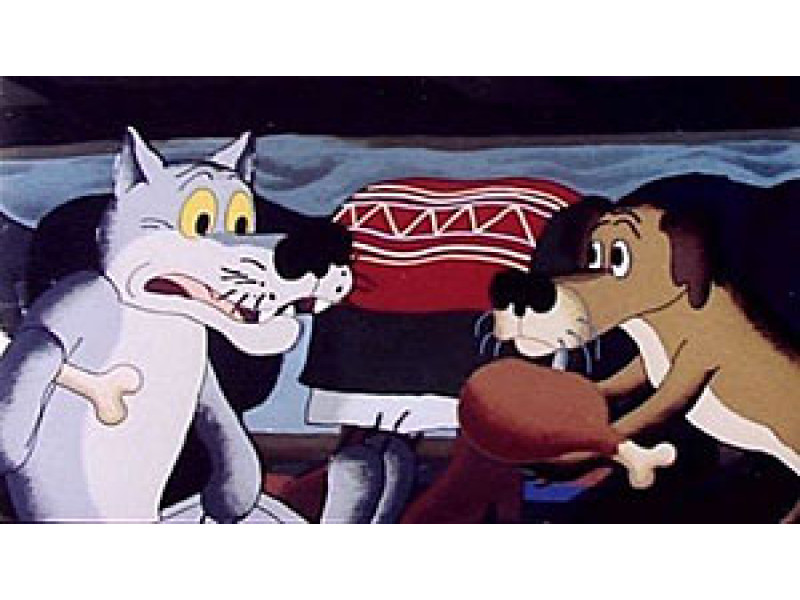The idea of creating a cartoon is a matter of many years
… One day, the father of the future director Eduard Nazarov brought his son a book, in which he immediately noticed a mistake. “Oh, look, there’s one letter missing on the cover, it says “Tales”, not “Fairy Tales”, – he complained to his father. Dad explained that the book was written in Ukrainian and there were no mistakes here. Edik mastered it without any special problems (“The languages are similar”, – Nazarov told in an interview with “Korrespondent” in 2012). Actually, this is how the idea of the cult “Once Upon a Time in a Dog” was born – a cartoon that is still a supplier of a great variety of catchy expressions; a cartoon that, it seems, will never lose its relevance.
It was 1980. Stanislav Govorukhin's five-part film "Meeting Place Cannot Be Changed" had just been released across the Soviet Union. On every corner, boys could be heard desperately trying to repeat the legendary "I said, Hunchback!"... At the same time, Eduard Nazarov, already a fairly experienced animator and author of the Soviet cartoon "Winnie the Pooh", traveled to Kyiv, where he obtained musical materials for the future masterpiece. The Metropolitan Institute of Folklore and Ethnography of the Academy of Sciences of the Ukrainian SSR presented Nazarov with a tape reel with folk songs recorded by ethnographers traveling through Ukrainian villages. An attempt to start a conversation about the financial part of the issue turned into a friendly insult for the director from the Institute's employees: "A gift, they say. Why are you insulting us?!" As a result, five works from this collection, including "Oh, there on the mountain", "Father mowed, I mowed" and others, were included in the film. All of them were performed by the ensemble from the Poltava village of Kryachkivka - "Drevo", created in 1958 and existing (though with a different composition) to this day.
Surely, in our time, the fact that "Once Upon a Time a Dog" was filmed by a Russian director causes notes of pleasant surprise, because all nine minutes of the film, with an extra one, are permeated with Ukrainian national flavor, which is manifested in many elements of the picture. And the credit for this belongs to Eduard Nazarov. A true expert in his field, he did not want to shoot on behalf of the Soviet leadership, and therefore traveled around Ukraine in search of materials. "Initially, the script for my new film was written by a professional, Seryozha Ivanov. I did not like it. I did not want to shoot about pioneers and space. And I took up a "telegraph" fairy tale - only fifteen lines. About the meeting in the forest of an old wolf with an old dog. "You will help me, and I will help you." "The only phrase that was going through my head at that time was, 'I'll sing it right now!'" the author recalls thirty years after the release of "The Dog..." on wide screens.
The thoroughness and inspiration with which Nazarov collected materials for his fifth film as a director is truly impressive. And if the musical component, which became one of the pearls of the film, has already been mentioned above, it is worth mentioning other sources that inspired Eduard Vasilyevich. In the 70s, he often visited his army comrade in the town of Tsyurupinsk, Kherson region. According to Nazarov, Tsyurupinsk resembled a large village, where one could find whitewashed huts covered with reeds, and boys and girls singing songs on warm evenings. "In general, I grabbed something from there - the mood, the smell. All this appealed to the soul and migrated into the film," says the author.
Visits to the famous Pirogovo and some ethnographic museums in Lviv provided Nazarov with considerable help in creating a vivid image of the Ukrainian village. It was here that he made sketches of clothes, household utensils, dishes and other small, but necessary for the picture, things. Travels through Ukraine resulted in an animated film in two parts with a total running time of 15 minutes.
Fighting “Soviet” censorship
But even these fifteen minutes were not destined to reach the masses. The obstacle was the management of Soyuzmultfilm, with whom Nazarov (and not only him) had certain differences of opinion. It had to be shortened to ten minutes: "I wanted the story to be an expressive narrative, but in the end, some things came out as a tongue-in-cheek. For example, the scene where a wolf and a dog sit on a mountain and howl at the moon, I would have liked to make longer. In general, purely psychologically, many moments could have been made longer." But here, as in many other things, Nazarov had to submit to the whims of the head of the film studio.
As Eduard Vasilyevich would later say, for a long time he did not know about his own awards, which quickly fell into the hands of the Soviet cartoonists and were kept in their drawers. Later, when many even sued for the right to receive what they had honestly earned, Nazarov did not care - he simply “waved” his hand at these awards. “Once Upon a Time in a Dog” is almost the only picture by the author that was accepted by the distribution without any special problems. Although here too they were.
Inspired by the fairy tale “Sirko” he read in his childhood, Nazarov initially thought about calling the film “A Dog’s Life”. Agree, such a title prompted the “Goskino” officials to ask the author certain questions. “What do you mean by that?!” So that his work would not remain in a drawer, Eduard Vasilyevich had to change the “title”. And yet, Nazarov hid a certain detail from the watchful eyes of the censors. Yes, the author admits, a baby who was “stolen” by a wolf and “saved” by a dog – the prototype of Soviet Secretary General Nikita Khrushchev in his childhood.
"It's you, come on, if you don't." How was the legendary cartoon voiced?
The actors who voiced the main characters deserve special mention. Nazarov voiced most of his own cartoons himself – either out of desperation or due to lack of funds. They usually gave him four months to create a picture. If he didn’t manage it – your problems. This is precisely the reason why Eduard Nazarov actually reads the author’s text in “The Dog…”. The women’s cries during the “stealing” of a child are the work of the author’s wife, Tatyana. The result is a kind of family economy.
It is interesting that the wolf – the one we are used to and love – was planned to be completely different from the very beginning. The fact is that the character was drawn after the most famous film marshal Zhukov in the USSR – Mikhail Ulyanov, but he, citing his busy schedule and a large number of filming sessions, refused. Inviting Armen Dzhigarkhanyan to this role, Nazarov took a risk. And he took a risk not only because it was the animated debut for the talented native of Yerevan, but also because he had to redraw the “old” wolf, because it was disharmonious with the capabilities of Dzhigarkhanyan’s vocal cords. Having created a new image of the gray one, Eduard Vasilyevich began to worry: “When he [A. Dzhigarkhanyan] first entered the tone studio, there was a stack of sketches of the main characters on the piano. I see a hunched Armen Borisovich – well, the real Hunchback from “Meeting Place Cannot Be Changed”! And he approached the piano and looked at the same wolf I had drawn. I thought that Dzhigarkhanyan would be offended and kill me. But he looked and croaked: "What, nothing. A beautiful wolf! Let's work!"
Everything was clear about the dog from the very beginning. His voice was taken on by Georgy Burkov. This lightning-fast duo [Dzhigarkhanyan–Burkov] would later work together on “The Adventures of Piglet Funtik” (1986–88), where Georgy Ivanovich would speak for the hippopotamus Shokolad, and Armen Borisovich would speak for Uncle Mokus.
“Sirka” was recognized by the whole world
Having been released in 1982, "Once Upon a Time in a Dog" began to rapidly gain popularity among wide circles of people around the world. A year later, the film took first place at the International Film Festival in Odense, Denmark, and "with a bang" "The Dog.." also "entered" in Poland, Yugoslavia, and Australia. In 2012, at the Suzdal Animated Film Festival, Nazarov's work was recognized as the best achievement of the animation genre in the last 100 years. In recent years, the fashion for erecting various monuments in honor of the legendary picture has become widespread - similar pedestals adorn Kyiv on Gonchar Street, in the village of Petrovske near the capital, and also in Tomsk, Russia.
What is the reason for such popularity of a seemingly rather primitive, short film, which is already over thirty years old?! Eduard Vasilyevich Nazarov himself aptly answers this question: "Cinema for yourself is madness. For yourself, it is better to write pictures or communicate using a computer. And when making a film, you must think about ensuring that the viewer does not fall asleep during your film."
Author: Maksym Timchenko.








Write a comment